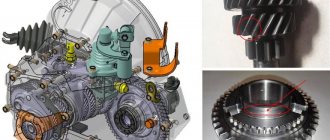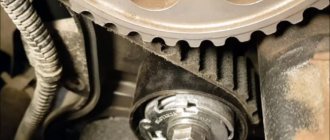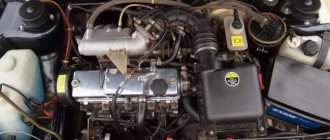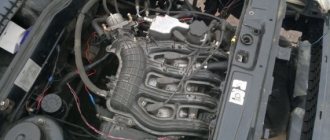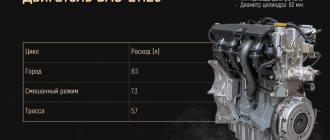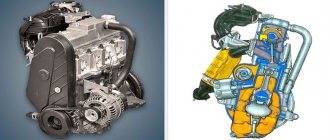Engine options for Vesta
Here we consider options related to cars currently being produced or those that will begin to be produced in the near future. An 8-valve engine was also developed for Vesta - it definitely does not bend the valves and will definitely not be installed on top-end sedans in 2016.
Read more about the engines with which the Lada Vesta line is equipped in the material: What engines are installed on the Lada Vesta: technical characteristics and their service life!
ICE VAZ-21129, 106 “hp” (valve bending)
Under the hood of the 106-horsepower Lada Vesta
A little history. Motor 21129 is a modified version of another engine, namely 21127. The last of them, when the timing belt broke, successfully bent its valves, although grooves were made on the pistons (Fig. 1). The point is that the depth of the grooves was not sufficient: if certain conditions were met, the valve “met” the piston with all the ensuing consequences.
With the transition to a new generation of internal combustion engines, that is, 21129, the design of the pistons was modified. But the external shape has not changed much, and although the recesses remain, their depth is still insufficient.
Here we considered the question of whether the Lada Vesta valves with the “21129” engine are bent. And the answer was clear: yes, oppression.
In theory, the problem with valve bending is typical for all VAZ engines equipped with 4 valves per cylinder. Each new 16-valve engine “inherits” it. The exception is one rarity - the VAZ-2112 internal combustion engine, the volume of which is 1.6 liters. There, the recesses are made conscientiously (Fig. 2).
122-horsepower engine “21179” (valve bending)
In terms of its design, the internal combustion engine of the VAZ-21179 is not very different from its predecessors. The working volume was increased to 1774 ml, which was achieved by changing the piston stroke length: it was 75.6 mm, it became 84.0 mm.
Elements of the connecting rod and piston group
The piston itself is now better fitted to the cylinder than in engines 21127 and 21129. The distance from the piston pin to the piston bottom has increased by 1.3 mm - to 26.7 mm. But deeper grooves in the bottom never appeared. The timing mechanism still drives the belt, and if it breaks, the possibility of bending the valves has not been canceled.
Now we know whether the valves bend on a Lada Vesta with a 1.8-liter engine. The answer will be the same as for all 16-valve VAZ internal combustion engines (with the exception of 2112). The problem with the transition to a new generation remains the same. But VAZ does not intend to return to “heavy” pistons.
The timing drive on 21179 engines is equipped with not one, but two tension rollers. What was done to make the design less susceptible to timing belt stretching.
It says here: the number of tension rollers is two
One of the automatic tensioners may jam, but then its function will be taken over by the second automatic roller.
Pistons that do not bend valves
Piston kits for some “old” 16-valve engines are produced by third-party companies. These parts are equipped with deep recesses. The point is that the piston does not reach the plates and cannot bend the valves.
Tuning piston for internal combustion engines 21126-21127
ShPG elements of different engines (21127, 21129, 21179) are compatible. But there is no need to install pistons from “old engines” into the Vesta engine:
- In ICE 21129, after such “tuning”, friction losses will increase;
- If pistons from the 26th or 27th engine are installed in the ICE 21179, the working volume will immediately change.
The “29th”, as well as the “79th” Lada Vesta engine bends valves only with “VAZ” pistons. But after installing a “tuning” part, do not expect an increase in power. Also, by using non-standard elements, you can greatly reduce the resource (lose the warranty, get unforeseen consequences).
Nissan HR16DE engine (does not bend, there is a chain)
In most trim levels with a manual transmission, the Vesta sedan is equipped with a Nissan engine. This engine is planned for installation on bodies: station wagon, crossover and coupe! Its name is HR16DE, and its displacement is 1.6 liters. Let's look at what the piston crown looks like.
HR16DE engine disassembled
There are no “deep recesses” provided here. Now let's pay attention to how the timing drive mechanism works.
Nothing but gears and chains
There is no toothed belt here - it is replaced by a chain. It is difficult to imagine the following two situations:
- The chain could have jumped over the teeth of one or more gears;
- One of the elements was damaged so badly that the presence of damage led to rupture.
As long as the chain remains intact, the valves and pistons cannot meet each other, no matter what happens to the engine. The only bad thing is that the chain may jam.
Do the valves of a Lada Vesta with a Nissan internal combustion engine bend? The answer “no” would be wrong - a circuit break is not excluded. But in reality it will be almost impossible to face such a situation. Let's look at why.
Comments • 35
VESTA MARCH 2022 ru-stop.com/video/C0Dnyu4o6fU-video.html
People. The author of this video is correct. You can use his simpler method (through an endoscope) to check on your Westies without plug/plug, so as not to take off the belt! I have a video of the Vesta 1'6 camshaft scrolling with the belt off (I changed the rollers and filmed it at my request), today a friend took it and sent it to me. WITHOUT STICKING. I posted this video on my YouTube channel, go to my profile and watch on my channel, everyone who doubted this. Now there is 100% proof that the pistons on the latest Wests are plugless, which means checking with an endoscope is also a good and easy way to check the pistons!
MikRSmile on Lada Granta 16 the valves bend. If you install pistons with grooves like yours.. the valves don’t bend.
Everything has its own resource, I’m not sure, change the belt and everything that comes with it, right down to the camshaft seals, it will come out cheaper, don’t tempt fate
@MikRSmile Both temperature and burning rate. These are the cheap gas spark plugs I am currently testing at my shop.optorg.ru/catalog/?id=202572 The tactics here are simple. Either they are expensive and will last longer, or they are cheap and you will need to change them more often. In terms of money it will come out almost the same, expensive candles will cost even a little more in the end, and they make a lot of fakes for expensive candles, you can easily get into trouble with them, i.e. You'll be throwing money away. There are practically no counterfeits for cheap candles, which means there is no risk. Changing more often is also better for coils. Well, here’s one of the many articles about gas candles, temperature and burning rate are also mentioned there. www.google.com/amp/s/www.zr.ru/content/amp/articles/236580-svechi_zazhiganija_ili_gazovyje_zazhigalki/ We left the unconnected topic thanks to your questions, and with this topic everything is already clear.
@Mykola Maidanuty Well, it’s not the combustion temperature, but the combustion rate is different. as long as I remember. Crap. Now we're off topic
@MikRSmile, in fact, the new equipment has its own ECU unit, which is adjusted, but this does not prevent burnout, which occurs due to the higher temperature of gas combustion, especially at high speeds. For this purpose, the gas ECU turns off the gas supply after 3000 rpm, but I and many others decided to disable this function; I rarely reach such rpm, only when overtaking and then sometimes. It is for this reason that other candles are needed, and also because it is harder to ignite gas than gasoline, but the arson of gas is solved by reducing the gap on ordinary candles, which do not tolerate the high temperature of gas combustion for a long time, which is why special candles are needed. In theory, we need other valves, and even better, another head. There is one more point. Due to the purity of the gas, especially methane, gas, unlike gasoline, which contains impurities, dries out the engine, i.e. Doesn't lubricate like gasoline.
@Mykola I'm confused about the burnout of the valves, this is all due to the fact that the ECU unit is not reconfigured for gas.
@MikRSmile I’m not campaigning for gas, you asked the questions yourself, I answered. The bulge on the floor is not very large and very unnoticeable, it doesn’t bother me at all. I just coveted a large balloon, but a slightly smaller balloon is no longer higher than the floor and does not give any bulge at all. If you are looking for problems with gas with your questions, then it has a certain problem, despite all its advantages, such as the fact that it does not cause carbon deposits and the engine from it is generally clean, but valves burn out from both gases. Even with new equipment, they burn out, just later than with the old one, but this drawback (repairs) is still covered by good savings on gas until they raise gas prices, and you still still have a good advantage in terms of money. And by the way, Vestas have hydraulic compensators and therefore there is no need to adjust the valves, as on other cars with gas, but without hydraulic compensators, this is already a plus for Vesta and gas.
Four Well-Known Facts
The service life of the timing chain always exceeds the service life of the engine. This is the first fact, but a condition must be met: the oil change must be timely. In general, the circuit fails gradually, and this is accompanied by symptoms:
- Audible sounds (chirping) at idle speed;
- When the “problem area” passes, a phase shift may be observed.
The last defect is detected using computer diagnostics.
From the appearance of any symptom to the complete rupture of the chain, a certain time passes. And in general, a “defective circuit” can work for a long time. This was another, fourth fact.
Source
Factory standard fuel consumption indicators for Lada Kalina
There are four main models of the Lada Kalina passenger car:
- sedan - has a closed body, with 2-3 rows of seats for the driver and passengers, the trunk is separated from the car interior, there is no lifting door in the rear wall;
- station wagon - has a closed cargo-passenger body, one of the sedan variants, which has an enlarged luggage compartment, is equipped with a lifting door in the rear wall;
- hatchback - has a body with 1-2 rows of driver and passenger seats, with a shortened rear overhang (hence the name - “hatchback” means “short”) and a smaller luggage compartment, equipped with a lift-up door in the rear wall;
- sport - is a sports version, which is equipped with a number of special parts - a bumper, an exhaust pipe tip, sports pedals, alloy wheels, a SAAZ Sport sports suspension, front and rear disc brakes, an original reinforced gearbox.
In this case, the following parameters of the vehicle itself are taken into account:
- Engine size (Lada Kalina comes in two types - 1.4 l and 1.6 l).
- Number of valves (for Lada Kalina - 8 and 16).
Experts have prepared an information table that shows the factory fuel consumption indicators for each model of the Lada Kalina passenger car, taking into account the mandatory parameters.
| Model Lada Kalina | 1.6 l (8 valves) | 1.6 l (16 valves) | 1.4 l (16 valves) |
| sedan | 7,8 | 7,2 | 7,0 |
| station wagon | 7,3 | 7,2 | 7,0 |
| hatchback | 7,3 | 7,3 | 7,0 |
| sport | – | 7,8 | – |
The manufacturer sets the standards for digital fuel consumption indicators for each Lada Kalina model based on the results of test runs of passenger cars on a special track. But on the track, driving conditions are reduced to ideal, and the car is driven by an experienced driver.
In real conditions, everything becomes much more complicated. In addition, the speed indicator during real driving is not always within the required limits - from 100 km/h to 120 km/h. This is due to the fact that some drivers do not recognize the established framework for optimal driving of a Lada Kalina car, which significantly affects fuel costs.
Do Lada Vesta and Lada Xray engines bend valves?
The Lada Vesta and Lada Xray have 3 engine options, all 16-valve. What happens if the timing belt breaks? Will the valve bend or not? Let's find out in this article.
Look. Lada Vesta and Lada X-ray have 3 engines:
- 21129 - volume 1.6, power 106 horsepower
- H4M - Nissan engine, power 113 horsepower
- 21179 - volume 1.8, power 122 horsepower
Regarding the first two the situation is as follows
. There are grooves on the pistons, but until July 2022 they were not deep enough. When the timing belt breaks, the pistons bend the valves. By the way, the H4M engine does not have a belt, but a chain. This is more reliable, but still does not provide a 100% guarantee.
Since 2022, pistons from a third-party supplier have been installed on Vesta and Xray. They have deep grooves, and now the engines have become plug-inless, i.e. If the belt breaks, the valves are safe.
New pistons have appeared on cars produced after August 15, 2022. If you have a 16 valve engine and a car made after this date, then it has a plugless engine.
The new pistons are produced by the American company Federal Mogul, which has a plant in Togliatti. Why AvtoVAZ itself could not make the grooves deeper is a mystery. Let's accept this as a fact.
Now about the 1.8 engine
. This is also a 16 valve engine. Unfortunately, new pistons are not installed on it, so a broken timing belt leads to damage to the valves. Whether this will change is not yet clear. AvtoVAZ’s official response is this: new pistons will appear on these engines if the company sees a request from customers, which has not yet occurred.
Source
Belt brands, prices and articles, originals and analogues
For VAZ-11189 engines, the timing belt drive is officially supplied by the well-known Belgian company Gates. The belt number of this brand is 21080100604082. The average price is 320 rubles. The most popular analogue of this belt has article number VT25009. Manufacturer – VKT (China). The price tag starts from 250 rubles.
Power units 21129 and 21179 are equipped at the factory with belt drives from Renault (which is the official supplier of Lada parts) with number 8201069699. The average price is 1,300 rubles.
Characteristics of timing belts for Lada Vesta cars
| ICE | Number of teeth | Width (mm) | Length (mm) |
| 8-valve 11189 | 111 | 19 | 1057 |
| 16-valve 21129 and 21179 | 132 | 27.4 | 1257 |
If we talk about the most popular analogues of timing belts for Vesta, then Gates, Contitech, Dayco and Bosch offer the most promising parts in this segment.
A belt with article number CT 1179 from Contitech (Germany) costs on average 750 rubles. The belt drive from this company is even more popular than the original.
An analogue belt for Vesta under article number 5671 XS from Gates costs about 1,300 rubles. The quality and parameters are similar to the original. Customer reviews are mostly positive.
And another timing belt that is worth paying attention to is offered by the popular German manufacturer Bosch. Number – 1987949686. Average price – 1000 rubles. The item has positive customer reviews.
Of course, it is better to immediately buy a timing belt kit along with rollers, the average cost of which for Lada Vesta starts from 3,500 rubles.
Similar:
- Timing belt Daewoo Nexia During the operation of the Daewoo Nexia car, the timing belt gradually wears out. To maintain the performance of the power unit, periodic maintenance of the gas distribution mechanism drive is required. Perform replacement.
- Renault Duster timing belt Sooner or later, all parts fail. It is necessary to change the timing belt after each crossing of a threshold of 60 km, or when strangers appear in the engine.
- Timing belt Lada Kalina The main task of the timing belt is to transmit torque from the crankshaft to the camshaft for subsequent driving of the car. Violation of operating conditions, poor quality.
- Timing belt Ford Focus 3 The performance of the power plant depends on the condition of the timing belt. Its breakage leads to a lot of troubles, including damage to the valves, destruction of the pistons and the appearance of scuffs on the surface.
Design features of engines on Lada Vesta
Models are equipped with one of three types of gasoline engines:
- VAZ 21116 (1.6 / 8 cl. / 87 hp);
- VAZ 21127 (1.6 / 16 cl. / 106 hp);
- Renault-Nissan HR16DE-H4M (1.6 / 16 cl. / 114 hp).
The first two modifications are domestically produced with a volume of 1.6 / 1.8 liters and a power reserve of 106 hp. valves are bent. The third model is an imported development by French engineers, where a chain is installed instead of a belt drive, and as a result, there is no bending of the valves.
The most powerful Lada engine will become “plug-inless”
The Volga auto giant continues a large-scale modernization of its existing line of power units. It is planned that the most powerful (122 hp) VAZ 1.8-liter engine with the VAZ-21179 index will soon receive a “plug-inless” version. This will happen in the middle of the summer of this year, reports the Quto.ru portal. Therefore, the Russian automaker will completely switch to “plug-in” engines.
Nevertheless, despite the innovation, employees of the company’s dealer network told RG that out of all the cases of timing belt breakage on 1.8-liter engines, bent valves have never been encountered.
Let us remind you that from July 2022, AvtoVAZ began using the latest so-called “plugless” pistons (with recesses) in all 1.6-liter engines. If the timing belt breaks, the valves, thanks to the optimization of the shape of the pistons, do not collide with them (do not bend). This allows car owners to avoid expensive and time-consuming repairs. You can safely drive such engines until the belt breaks or the pump jams. The supplier of pistons with special “selections” is Federal Mogul.
The new piston group was created for a number of engines: the 8-valve VAZ-11186 with a power of 87 hp. s., 16-valve engines VAZ-21126 (98 hp) and VAZ-21127 (106 hp), also 106-horsepower VAZ-21129 (Lada Vesta, Xray, Largus) and 122-horsepower VAZ- 21179. The extreme one is installed only on the Lada Vesta and Xray family of cars.
By the way, modern engines of most automakers do not have pistons with grooves, since their presence has a bad effect on the power and environmental characteristics of power units.
By the way, earlier in a number of media (mass media, mass media - periodicals, radio, television and video programs)
it was said that the 1.8 liter VAZ-21179 engine with a power of 122 hp. will receive the latest modification with the VAZ-21178 index. The new version of the engine is capable of producing up to 136 horsepower (+14) due to the introduction of a dual variable valve timing system and a system of variable length intake ducts.
It should be noted that under the hood of the most expensive and powerful production model in the history of the Lada brand – Vesta Sport – there is a forced 1.8-liter engine with a capacity of 145 hp. and a torque of 187 Nm. The modified engine features new camshafts with a modified profile (cam lift is increased), increased pressure in the fuel system and a unique controller calibration.
Moreover, some Lada Vesta R registered by AvtoVAZ in December 2022 can supposedly be equipped with a 1.8-liter engine, boosted to 180 horsepower.
Previously, we reported that AvtoVAZ plans to increase the production of its own engines to record specifications.
Source: rg.ru
Problems with the VAZ 21116 engine
This is an improved power unit from the VAZ 21114. The connecting rod and piston group was lightened by 40%, replacing the materials with aluminum alloy. If the belt drive breaks, the valve heel does not bend.
Engine design features
- the valve mechanism must be adjusted at intervals of 45,000 km;
- the oil filter needs to be changed more often than other models (10,000 km);
- rapid wear of the cooling system elements occurs;
- Frequent engine oil leaks occur due to depressurization of sealing gaskets;
- The clamping nuts on the exhaust exhaust pipe burst and need to be replaced with brass ones.
Typical faults
- Detonation during operation: measure the compression in each cylinder. A deviation of 1.0 atmospheres or more is a sign of valve burnout. A difference of up to 1.0 atmospheres is a sign of wear on the rings or damage to the sealing gasket.
- Unstable speed: diagnose the throttle position sensor, adjust idle speed.
- The engine temperature does not rise above 40°: the thermostat is faulty, replace it with a new one.
- Uncharacteristic knocks and noises when the engine is running: a metallic knock is a sign of a malfunction of the connecting rods and crankshaft bearings. Piston knocking is less common. To troubleshoot the problem, contact a service station for help.
The most powerful Lada engine will become “plug-inless”
The Volga auto giant continues a large-scale modernization of its existing line of power units. It is planned that the most powerful (122 hp) VAZ 1.8-liter engine with the VAZ-21179 index will soon receive a “plug-inless” version. This will happen in the middle of the summer of this year, reports the Quto.ru portal. Therefore, the Russian automaker will completely switch to “plug-in” engines.
Nevertheless, despite the innovation, employees of the company’s dealer network told RG that out of all the cases of timing belt breakage on 1.8-liter engines, bent valves have never been encountered.
Let us remind you that from July 2022, AvtoVAZ began using the latest so-called “plugless” pistons (with recesses) in all 1.6-liter engines. If the timing belt breaks, the valves, thanks to the optimization of the shape of the pistons, do not collide with them (do not bend). This allows car owners to avoid expensive and time-consuming repairs. You can safely drive such engines until the belt breaks or the pump jams. The supplier of pistons with special “selections” is Federal Mogul.
The new piston group was created for a number of engines: the 8-valve VAZ-11186 with a power of 87 hp. s., 16-valve engines VAZ-21126 (98 hp) and VAZ-21127 (106 hp), also 106-horsepower VAZ-21129 (Lada Vesta, Xray, Largus) and 122-horsepower VAZ- 21179. The extreme one is installed only on the Lada Vesta and Xray family of cars.
By the way, modern engines of most automakers do not have pistons with grooves, since their presence has a bad effect on the power and environmental characteristics of power units.
By the way, earlier in a number of media (mass media, mass media - periodicals, radio, television and video programs)
it was said that the 1.8 liter VAZ-21179 engine with a power of 122 hp. will receive the latest modification with the VAZ-21178 index. The new version of the engine is capable of producing up to 136 horsepower (+14) due to the introduction of a dual variable valve timing system and a system of variable length intake ducts.
It should be noted that under the hood of the most expensive and powerful production model in the history of the Lada brand – Vesta Sport – there is a forced 1.8-liter engine with a capacity of 145 hp. and a torque of 187 Nm. The modified engine features new camshafts with a modified profile (cam lift is increased), increased pressure in the fuel system and a unique controller calibration.
Moreover, some Lada Vesta R registered by AvtoVAZ in December 2022 can supposedly be equipped with a 1.8-liter engine, boosted to 180 horsepower.
Previously, we reported that AvtoVAZ plans to increase the production of its own engines to record specifications.
Source: rg.ru
Problems with the VAZ 21127 engine
This is an improved model from the VAZ 21126. Innovations include a new intake system, the shape of a resonance chamber and adjustable dampers.
In order to eliminate floating speed, the mass air flow sensor was replaced with two new sensors: DBP and DTV.
Like the previous type of engine, the VAZ 21127 bends the valve when the belt breaks.
Peculiarities
- difficulty starting the engine is caused by irregularities in the timing;
- due to low pressure in the fuel system, air leaks, the engine does not operate stably;
- a burnt gasket is a source of engine power loss;
- wear of the piston rings is the cause of increased fuel and engine oil consumption.
The motor also bends the valve when the belt breaks. The problem can be solved by replacing the pistons with a plugless type.
Typical faults
- ICE tripping at idle and under load;
- premature failure of the ignition coil;
- errors in the antifreeze temperature sensor in the cooling system.
Engine 21129 and variable geometry intake
The intake has undergone a radical change; the intake manifold has a system of dampers, with their help the {filling} of the cylinders (with air) is regulated. A conventional intake ensures the correct flow of air within a certain range of engine operation.
With the help of dampers 129, the engine is able to completely fill the combustion chamber. At low crankshaft rotation, the air moves along a long path. At high speeds over a short period.
The operating mode is switched by the control unit. Instead of the familiar mass air flow sensor, an absolute pressure sensor and an air temperature sensor are used.
What else does AvtoVAZ give?
The latest AvtoVAZ models require environmentally friendly engines, this is another reason for the creation of the 21129 engine. The engine was adjusted to Euro-5 standards: they changed the intake, reduced the exhaust, added a Euro-5 catalyst, changed the firmware of the M86 ECU - ready. The motor was also adapted for different gearboxes.
- Checkpoint (Checkpoint - a point designed to control passage (visit) and access to the territory of any facility) Renault (cast crankcase) volume 4.4 liters.
- RKP (stamped crater) with a volume of 3.2 liters.
Renault-Nissan HR16DE-H4M
The engine was manufactured in 2006 and is considered the most powerful in the VAZ line. The average service life before major repairs is 255,000 km.
The unit can consume both standard AI-95 and AI-92 fuel. Unlike its “brothers”, this model has a chain drive rather than a belt drive.
Typical faults
- incorrect operation of the ignition unit;
- alternator belt whistling: tighten it, replace it with a new one;
- vibrations during internal combustion engine operation: replacing the engine mount;
- The exhaust sound becomes louder than usual: replace the gasket.
Final stage
Don't forget to install the crankshaft pulley spacer.
Make sure the automatic tensioner is working properly by turning the crankshaft. If it is noticed that it is not working properly and the tension is not maintained in one position, replace it with a new one.
Buy tension rollers only from trusted manufacturers, since if they fail, the timing belt will break.
Perform the following work in order:
- Use a hex key to secure the drive covers. Install the bottom half first, then the top.
- Using an E12 Torx wrench, tighten the motor mount bolts with a slight force, not completely.
- Loosely tighten the remaining 2 bolts using a 16mm socket wrench.
- Finally tighten the first bolts to a force of 54 to 72 N/m.
- Install the motor mount along the outlined contour, tighten the remaining 2 bolts with the same force.
- Unhook the crossbar from the engine and remove it from the vehicle.
- Insert a flat-blade screwdriver into the starter mounting hole to stop the flywheel from turning.
- Using a 17mm wrench, remove the crankshaft bolt.
- Install the pulley and secure it.
- Put on the alternator belt.
- Replace and secure the starter.
- Install the wheel arch mudguard.
- Replace the wheel.
- Connect the negative terminal of the battery.
New Lada: How to clean the air conditioner on a Priora? (solved) - 1 answer
After carrying out such work, replacing the timing belt on the Lada Vesta can be considered complete.
Pistons that do not bend valves
Upgraded pistons for 16 valves are manufactured by third-party companies. The seat sockets are equipped with deep recesses so that the piston heel does not reach the base.
Non-bending valves are compatible and interchangeable with internal combustion engines 21126-21127 (21127, 21129, 21179). The valve bends only on VAZ pistons.
However, installing tuned versions will not bring an increase in power. Don't expect an increase in engine power, but an increase in operating temperature and friction force are guaranteed.
Factors affecting the service life of the VAZ 2170
According to the manufacturer, the ICE 21126 with sixteen valves has a stable operation duration of 200 thousand kilometers. After a certain mileage it is necessary to carry out major repairs. Taking good care of the VAZ 2170, proper maintenance (MOT) and timely replacement of damaged components and parts will lead to a long service life of the vehicle.
Reasons affecting the service life of the power unit:
- Engine overheating. Elevated temperatures of a running engine negatively affect the overall service life of the motor. Maintaining the operating temperature of the power unit elements at a constant level significantly extends its operating time.
- Fuel. The vehicle's owner's manual contains detailed information about the recommended brand of gasoline. Filling the 16-valve Priora engine with fuel must be of proven quality.
- Machine oils. Which oil is best to fill, its brand and how much lubricant is needed is indicated in the accompanying documentation for the car. The 126 sixteen valve engine accepts semi-synthetic and synthetic motor oils most well. A complete oil change should be carried out annually or after a mileage of 15 thousand kilometers.
The optimal operating engine temperature is 90 - 95 °C. The rules allow the power unit to operate at temperatures reaching up to one hundred degrees, provided that the radiator fan is running. The engine temperature is considered low if it is below 90°C. In cold weather, it takes more time to warm up the engine to the desired mark on the device.
Why does the break occur?
- long-term operation of the belt drive;
- weakened tension;
- crankshaft defect;
- wear of pump teeth;
- camshaft defect;
- the tensioner is loose;
- insufficient clearance between the valves and the piston head.
How to identify problems with the timing belt?
- At idle you can hear the engine whirring;
- reduction in power, lack of strength when overcoming a road obstacle;
- increased fuel consumption.
How to determine deformation and damage of elements?
Order preventive maintenance exclusively from a service station; it is extremely difficult to carry out diagnostics yourself without special equipment.
After dismantling and disassembling the piston group into its component mechanisms, each of the pistons is subjected to lengthy testing on a diagnostic bench.
The resulting final data is analyzed, the master makes a decision on the advisability of preventive maintenance and replacement of parts with new ones.
Replacing the timing belt in engine 21129
Replacing the timing belt is a common procedure not only for owners of Russian cars.
- Remove the terminal from the battery;
- The wheel is on the right side too;
- Remove the drive belt of the suspended equipment;
- Remove the decorative cover behind it, the timing cover;
- Disconnect the right support;
- While moving the crankshaft, compare the marks on the camshafts and the marks on the cylinder head cover; a 17 key will come in handy;
- The crankshaft mark must match the mark on the oil pump:
- Using a screwdriver, secure the crankshaft using the holes for the starter (it is necessary to remove the starter);
- Unscrew the crankshaft bolt and remove the generator pulley;
- Unscrew the three bolts of the lower timing cover;
- Loosen the auto-tensioner bolt (head a 15);
- Remove the timing belt;
- Put on the new belt (First the crankshaft, later the right (intake) camshaft);
- Using pliers (or a special wrench), rotate the tensioner until the two marks coincide and tighten the tensioner bolt (torque from 30 to 36);
- We turn the crankshaft and check that the marks match.
- Install timing covers;
- We set up and secure the support;
- We carry out the remaining steps in reverse order (install the crankshaft damper, starter, mudguard, battery).
The bottom line is: an old, reliable, Euro-5, familiar VAZ engine. All that remains is not to forget about replacing the timing belt; it is still better to do this once every 60 thousand km or to carry out an inspection of the belt and bearing. Still, being left without a means of transportation on a long trip is an incomprehensible pleasure.
Source: kiapublic.ru
How to prevent element damage?
Not many car enthusiasts agree to install modernized pistons for the reasons described above. Service station technicians strongly recommend that you carry out a technical inspection in a timely manner, as well as install high-quality and original parts.
Consequences of a broken timing belt
Lada vesta angkor multimedia › logbook › timing drive lada vesta
Full size patient is ready Hello everyone! So the mileage is already 34 thousand kilometers, the sound of whistling when hot has appeared with a frequency of 1 time per second! I looked at the Priora forums and decided to do maintenance on the rollers, I’ll say right away that maybe someone doesn’t know, the timing belt and rollers with a pump easily fit from the Priora (126 engine). What is required: 1. jack2. garage with pit3. belt tension key Procedure: 1. remove the engine protection (if any) 2. place a beam across the pit 3. jack up the pan in front of the engine4. slightly raise the engine5.
unscrew 2 screws with an E12 head on the engine mount (unscrewed with a 10 head)6. unscrew the 2 bolts with head 167. pull out the engine mount8. raise the engine a little higher (in order to more conveniently unscrew the casing bolts)9. Unscrew the casing screws, there are 5 of them for a 510 hexagon. Take out the casing 11. We bring the camshaft pulleys to the marks on the rear wall of the casing 12. unscrew the support roller and the tensioner, then I removed the bearing cage and saw that there was practically no lubricant from the factory at all, besides, it was not of very good quality, the belt and rollers from GETS company cleaned it all in kerosene, pushed new grease for the bearings in there, put everything back together .
Full size, as you can see from the mark, the belt has been re-tightened from the factory!
Full size, this is what my version of the timing belt repair on the West looks like)
Full Size Plastic Roller Gets
Full sizing roller, zero lubrication
Full size tension roller, also not thick
Full size, for comparison, this is already a clean support roller RESULT There is no whistling and even the whistling that was always there has also disappeared! Now the videos are quietly moving for another 60 thousand! and then the pump needs to be changed.
Even 3 years ago, rumors began to spread across the Internet about the development of a new 1.8 liter engine at AvtoVAZ. The motor was intended for some new product that was kept secret. Now we already know that this development is the 1.8 Lada Vesta Cross engine.
Before this, there had already been attempts to develop a 1.8 engine, which was later successfully assembled by Lada’s subsidiary Super-Auto. This engine had the index 21128 and was even installed on the Lada Priora Sport for some time. But as time has shown, the motor turned out to be unreliable and had a short resource.
Signs of the need for internal combustion engine repair
The reasons why the operation of the engine is disrupted are arranged in a small list, starting with refusal to start and ending with floating idle speed (this problem was removed on the 127 “engine”). Not all breakdowns end in capital damage - sometimes it’s enough to add oil, sometimes it’s enough to adjust the ECU settings.
Compression reduction
A decrease in cylinder compression below 16 atmospheres is a bad sign. Such a high limit corresponds to a compression ratio of 11.
If the compression decreases (or vice versa increases), then the “engine” will have to be rebuilt.
Knocks in the engine
Engine knocks can come from several points. These could be hydraulic compressors, timing belt rollers or pins. The knocking noise could also be caused by low oil level. The answer to the question will be given by a thorough detailed inspection of all parts of the unit and checking the oil level.
Oil
The oil used in this engine is similar to 21126: synthetic, semi-synthetic
Oil sump volume
This point will be useful for those who are going to change the engine oil. With different transmissions, the volume of oil poured into the engine is also different.
- VAZ 21129 + Renault manual transmission (cast crankcase) = 4.4l
- VAZ 21129 + robot (stamped crater) = 3.2 l
The engine resource is 200 t. km. But in practice, you need to monitor the condition of the roller, pump and timing belt, because if individual valve elements jam, they will meet the piston group, and then both will come to an end. Therefore, those who are wondering whether the valve bends when the belt breaks, the answer is yes.
In addition, during the impact of these elements, it is not uncommon that the crankshaft bends slightly. You can drive with such a crankshaft, but there will be huge oil consumption.
Manufacturers
Timing kits, belts or rollers for VAZ engines are produced by:
- GATES
- CONTITECH
- DAYCO
- INA
- CORAM
- TORQUE
- POLENGA
- SNR
- BAUTLER
- LUZAR
- ROSTECO
- TRIALLI
- BRT
- and etc.
Determine the best timing kit, belt or pulley
We will do it by voting. Leave feedback in the comments, in which you can indicate:
- Which timing belt and rollers did you choose and why?
- How often do you change the rollers and timing belt?
Where can I buy?
These and other original parts are presented at low prices in our online store. Link to timing kit 8kl, timing kit 16kl.
We previously told you when to change the timing belt and rollers according to the manufacturer's regulations, as well as how to do it yourself.
Keywords: Lada Vesta engine | lada xray engine | Lada Largus engine | Lada Granta engine | Lada Kalina engine | Lada Priora engine | universal article
Found an error? Select it and press Ctrl Enter..
- Rating of cars by sales revenue in April 2022
- Tuning Lada Vesta SW Cross for 330,000 rubles
- What are the differences between Bosch and Kirzhach headlights on Lada Priora
- Installation of bumper and headlights from Kalina 2 to Grant and vice versa
Specifications
- Engine power 21129 (127) – 106 hp. (21126 – 98hp)
- Torque 21129 (127) – 150 N.m (21126 – 145 N.m.) at 4000 rpm.
- Mixed fuel consumption is 7-10 liters per 100 km. More details about fuel consumption
- Recommended fuel – AI 95
- Motor weight – 115 kg.
The table above shows the torque and power graph of the 1.6L 21129 engine and its comparison with the 21179 1.8L engine.

